2005 SAAB 9-2X wheel
[x] Cancel search: wheelPage 328 of 444
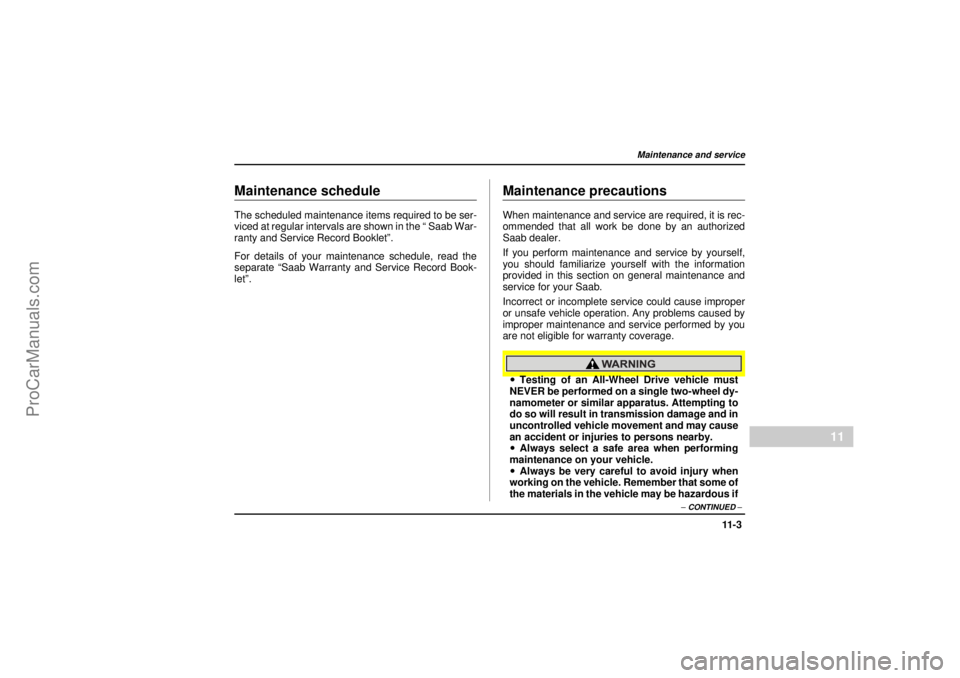
11 - 3
Maintenance and service
– CONTINUED –
11
18 February 2004
Maintenance and serviceMaintenance scheduleThe scheduled maintenance items required to be ser-
viced at regular intervals are shown in the “ Saab War-
ranty and Service Record Booklet”.
For details of your maintenance schedule, read the
separate “Saab Warranty and Service Record Book-
let”.
Maintenance precautionsWhen maintenance and service are required, it is rec-
ommended that all work be done by an authorized
Saab dealer.
If you perform maintenance and service by yourself,
you should familiarize yourself with the information
provided in this section on general maintenance and
service for your Saab.
Incorrect or incomplete service could cause improper
or unsafe vehicle operation. Any problems caused by
improper maintenance and service performed by you
are not eligible for warranty coverage.!Testing of an All-Wheel Drive vehicle must
NEVER be performed on a single two-wheel dy-
namometer or similar apparatus. Attempting to
do so will result in transmission damage and in
uncontrolled vehicle movement and may cause
an accident or injuries to persons nearby.
!Always select a safe area when performing
maintenance on your vehicle.
!Always be very careful to avoid injury when
working on the vehicle. Remember that some of
the materials in the vehicle may be hazardous if
ProCarManuals.com
Page 368 of 444
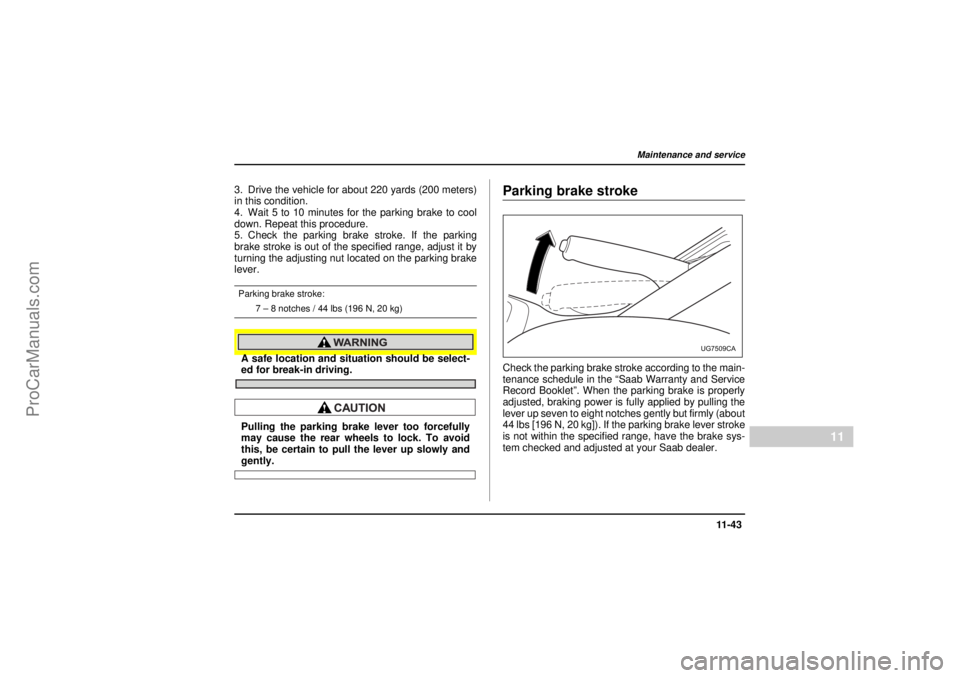
11 -4 3
Maintenance and service
– CONTINUED –
11
18 February 2004
3. Drive the vehicle for about 220 yards (200 meters)
in this condition.
4. Wait 5 to 10 minutes for the parking brake to cool
down. Repeat this procedure.
5. Check the parking brake stroke. If the parking
brake stroke is out of the specified range, adjust it by
turning the adjusting nut located on the parking brake
lever.Parking brake stroke:
7 – 8 notches / 44 lbs (196 N, 20 kg)
A safe location and situation should be select-ed for break-in driving.Pulling the parking brake lever too forcefully
may cause the rear wheels to lock. To avoid
this, be certain to pull the lever up slowly andgently.
Parking brake strokeCheck the parking brake stroke according to the main-
tenance schedule in the “Saab Warranty and Service
Record Booklet”. When the parking brake is properly
adjusted, braking power is fully applied by pulling the
lever up seven to eight notches gently but firmly (about
44 lbs [196 N, 20 kg]). If the parking brake lever stroke
is not within the specified range, have the brake sys-
tem checked and adjusted at your Saab dealer.
UG7509CA
ProCarManuals.com
Page 369 of 444
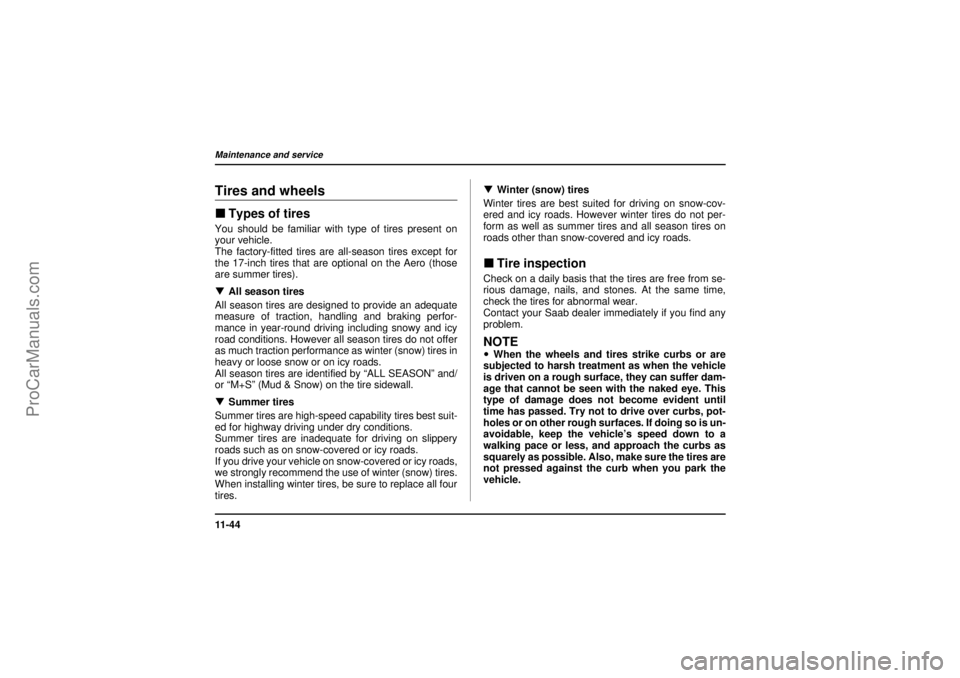
11 - 4 4Maintenance and service
18 February 2004
Tires and wheels"Types of tiresYou should be familiar with type of tires present on
your vehicle.
The factory-fitted tires are all-season tires except for
the 17-inch tires that are optional on the Aero (those
are summer tires).
!All season tires
All season tires are designed to provide an adequate
measure of traction, handling and braking perfor-
mance in year-round driving including snowy and icy
road conditions. However all season tires do not offer
as much traction performance as winter (snow) tires in
heavy or loose snow or on icy roads.
All season tires are identified by “ALL SEASON” and/
or “M+S” (Mud & Snow) on the tire sidewall.
!Summer tires
Summer tires are high-speed capability tires best suit-
ed for highway driving under dry conditions.
Summer tires are inadequate for driving on slippery
roads such as on snow-covered or icy roads.
If you drive your vehicle on snow-covered or icy roads,
we strongly recommend the use of winter (snow) tires.
When installing winter tires, be sure to replace all four
tires.!Winter (snow) tires
Winter tires are best suited for driving on snow-cov-
ered and icy roads. However winter tires do not per-
form as well as summer tires and all season tires on
roads other than snow-covered and icy roads.
"Tire inspectionCheck on a daily basis that the tires are free from se-
rious damage, nails, and stones. At the same time,
check the tires for abnormal wear.
Contact your Saab dealer immediately if you find any
problem.NOTE!When the wheels and tires strike curbs or are
subjected to harsh treatment as when the vehicle
is driven on a rough surface, they can suffer dam-
age that cannot be seen with the naked eye. This
type of damage does not become evident until
time has passed. Try not to drive over curbs, pot-
holes or on other rough surfaces. If doing so is un-
avoidable, keep the vehicle’s speed down to a
walking pace or less, and approach the curbs as
squarely as possible. Also, make sure the tires are
not pressed against the curb when you park the
vehicle.
ProCarManuals.com
Page 370 of 444
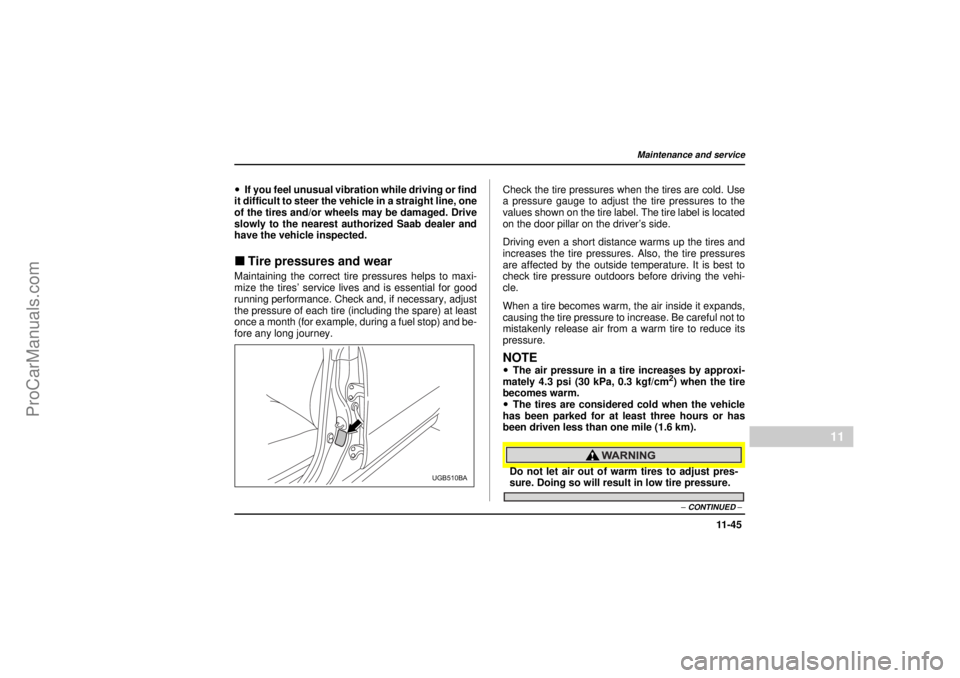
11 -4 5
Maintenance and service
– CONTINUED –
11
18 February 2004
!If you feel unusual vibration while driving or find
it difficult to steer the vehicle in a straight line, one
of the tires and/or wheels may be damaged. Drive
slowly to the nearest authorized Saab dealer and
have the vehicle inspected."Tire pressures and wearMaintaining the correct tire pressures helps to maxi-
mize the tires’ service lives and is essential for good
running performance. Check and, if necessary, adjust
the pressure of each tire (including the spare) at least
once a month (for example, during a fuel stop) and be-
fore any long journey.Check the tire pressures when the tires are cold. Use
a pressure gauge to adjust the tire pressures to the
values shown on the tire label. The tire label is located
on the door pillar on the driver’s side.
Driving even a short distance warms up the tires and
increases the tire pressures. Also, the tire pressures
are affected by the outside temperature. It is best to
check tire pressure outdoors before driving the vehi-
cle.
When a tire becomes warm, the air inside it expands,
causing the tire pressure to increase. Be careful not to
mistakenly release air from a warm tire to reduce its
pressure.
NOTE!The air pressure in a tire increases by approxi-
mately 4.3 psi (30 kPa, 0.3 kgf/cm
2) when the tire
becomes warm.
!The tires are considered cold when the vehicle
has been parked for at least three hours or has
been driven less than one mile (1.6 km).
Do not let air out of warm tires to adjust pres-sure. Doing so will result in low tire pressure.
UGB510BA
ProCarManuals.com
Page 372 of 444

11 -4 7
Maintenance and service
– CONTINUED –
11
26 December 2003
!Abnormally high tire pressure (tread worn in cen-
ter)
Ride comfort is poor. Also, the tire magnifies the ef-
fects of road-surface bumps and dips, possibly result-
ing in vehicle damage.
If the tire label shows tire pressures for the vehicle
when fully loaded and for the vehicle when towing a
trailer, adjust the tire pressures to the values that
match current loading conditions.Driving at high speeds with excessively low tire
pressures can cause the tires to deform severe-ly and to rapidly become hot. A sharp increase
in temperature could cause tread separation,
and destruction of the tires. The resulting loss
of vehicle control could lead to an accident."Wheel balanceEach wheel was correctly balanced when your vehicle
was new, but the wheels will become unbalanced as
the tires become worn during use. Wheel imbalance
causes the steering wheel to vibrate slightly at certain
vehicle speeds and detracts from the vehicle’s
straight-line stability. It can also cause steering and
suspension system problems and abnormal tire wear.
If you suspect that the wheels are not correctly bal-
anced, have them checked and adjusted by your Saab
dealer. Also have them adjusted after tire repairs and
after tire rotation.NOTELoss of correct wheel alignment* causes the tires
to wear on one side and reduces the vehicle’s run-
ning stability. Contact your Saab dealer if you no-
tice abnormal tire wear.*: The suspension system is designed to hold each wheel at
a certain alignment (relative to the other wheels and to the
road) for optimum straight-line stability and cornering perfor-
mance.
HSB054AA
ProCarManuals.com
Page 374 of 444

11 -4 9
Maintenance and service
– CONTINUED –
11
26 December 2003
"Tire rotationTire wear varies from wheel to wheel. To maximize the
life of each tire and ensure that the tires wear uniform-
ly, it is best to rotate the tires every 7,500 miles
(12,500 km). Rotating the tires involves switching the
front and rear tires on the right hand side of the vehicle
and similarly switching the front and rear tires on the
left hand side of the vehicle. (Each tire must be kept on
its original side of the vehicle.)
Replace any damaged or unevenly worn tire at the
time of rotation. After tire rotation, adjust the tire pres-
sures and make sure the wheel nuts are correctly
tightened.After driving approximately 600 miles (1,000 km),
check the wheel nuts again and retighten any nut that
has become loose.
"Tire replacementThe wheels and tires are important and integral parts
of your vehicle’s design; they cannot be changed arbi-
trarily. The tires fitted as standard equipment are opti-
mally matched to the characteristics of the vehicle and
were selected to give the best possible combination of
running performance, ride comfort, and service life. It
is essential for every tire to have a size and construc-
tion matching those shown on the tire label and to
have a speed symbol and load index matching those
shown on the tire label.
Using tires of a non-specified size detracts from con-
trollability, ride comfort, braking performance, speed-
ometer accuracy and odometer accuracy. It also cre-
ates incorrect body-to-tire clearances and inappropri-
ately changes the vehicle’s ground clearance.
All four tires must be the same in terms of manufactur-
er, brand (tread pattern), construction, and size. You
are advised to replace the tires with new ones that are
identical to those fitted as standard equipment.
For safe vehicle operation, Saab recommends replac-
ing all four tires at the same time.
HSB056BA
ProCarManuals.com
Page 376 of 444
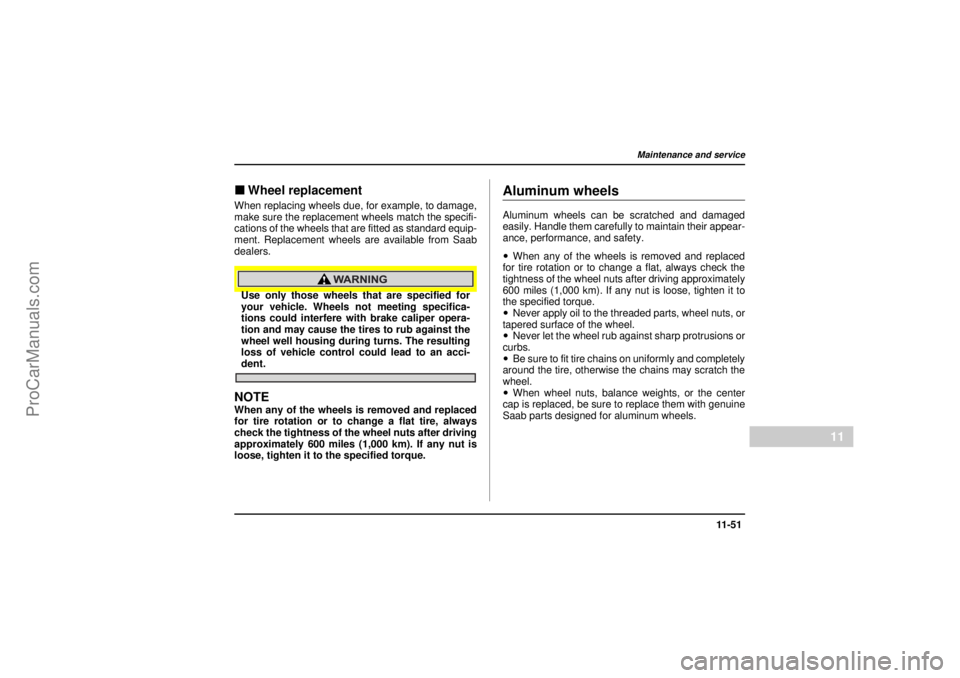
11 -5 1
Maintenance and service
– CONTINUED –
11
18 February 2004
"Wheel replacementWhen replacing wheels due, for example, to damage,
make sure the replacement wheels match the specifi-
cations of the wheels that are fitted as standard equip-
ment. Replacement wheels are available from Saab
dealers.Use only those wheels that are specified for
your vehicle. Wheels not meeting specifica-
tions could interfere with brake caliper opera-
tion and may cause the tires to rub against the
wheel well housing during turns. The resulting
loss of vehicle control could lead to an acci-dent.NOTEWhen any of the wheels is removed and replaced
for tire rotation or to change a flat tire, always
check the tightness of the wheel nuts after driving
approximately 600 miles (1,000 km). If any nut is
loose, tighten it to the specified torque.
Aluminum wheelsAluminum wheels can be scratched and damaged
easily. Handle them carefully to maintain their appear-
ance, performance, and safety.
!When any of the wheels is removed and replaced
for tire rotation or to change a flat, always check the
tightness of the wheel nuts after driving approximately
600 miles (1,000 km). If any nut is loose, tighten it to
the specified torque.
!Never apply oil to the threaded parts, wheel nuts, or
tapered surface of the wheel.
!Never let the wheel rub against sharp protrusions or
curbs.
!Be sure to fit tire chains on uniformly and completely
around the tire, otherwise the chains may scratch the
wheel.
!When wheel nuts, balance weights, or the center
cap is replaced, be sure to replace them with genuine
Saab parts designed for aluminum wheels.
ProCarManuals.com
Page 400 of 444
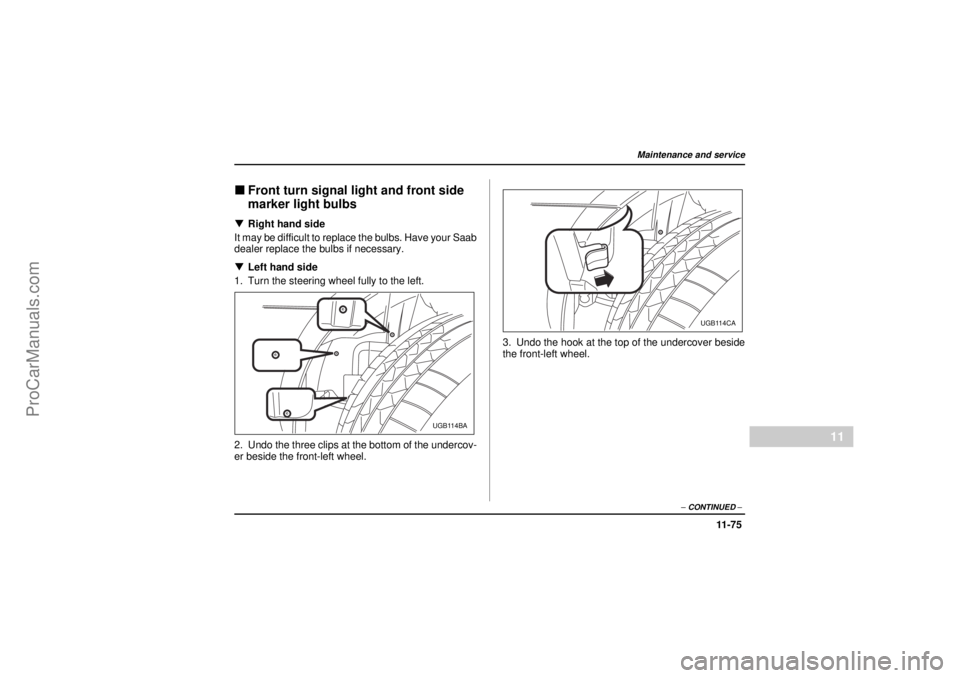
11 -7 5
Maintenance and service
– CONTINUED –
11
26 December 2003
"Front turn signal light and front side
marker light bulbs!Right hand side
It may be difficult to replace the bulbs. Have your Saab
dealer replace the bulbs if necessary.
!Left hand side
1. Turn the steering wheel fully to the left.
2. Undo the three clips at the bottom of the undercov-
er beside the front-left wheel.3. Undo the hook at the top of the undercover beside
the front-left wheel.
UGB114BA
UGB114CA
ProCarManuals.com